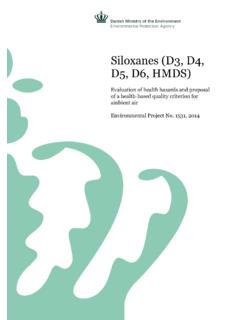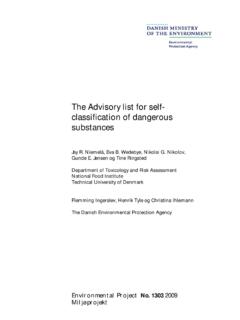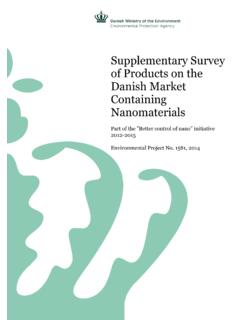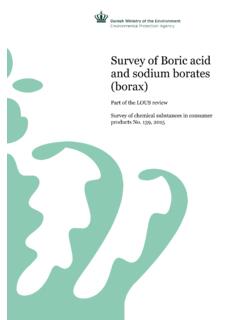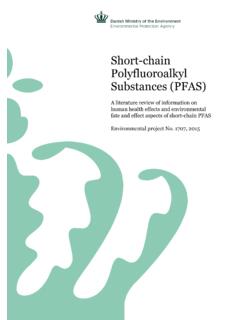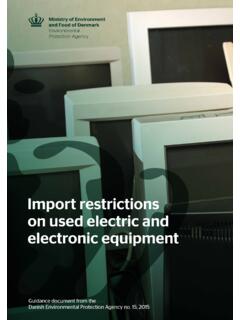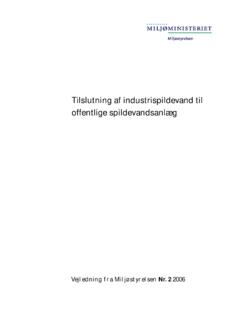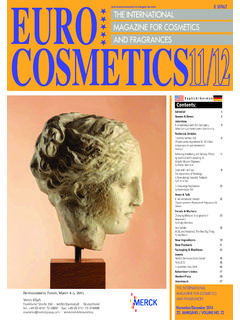Transcription of Siloxanes (D3, D4, D5, D6, HMDS) - Miljøstyrelsen
1 Siloxanes (D3, D4, D5, D6, HMDS). Evaluation of health hazards and proposal of a health-based quality criterion for ambient air Environmental Project No. 1531, 2014. Title: Editing: Siloxanes (D3, D4, D5, D6, HMDS) Krestine Greve, Elsa Nielsen, Ole Ladefoged. Division of Toxicology and Risk Assessment. National Food Institute, Technical University of Denmark Published by: The Danish Environmental Protection Agency Strandgade 29. 1401 Copenhagen K. Denmark Year: ISBN no. Authored 2010. 978-87-93026-85-8. Published 2014. Disclaimer: When the occasion arises, the Danish Environmental Protection Agency will publish reports and papers concerning research and development projects within the environmental sector, financed by study grants provided by the Danish Environmental Protection Agency.
2 It should be noted that such publications do not necessarily reflect the position or opinion of the Danish Environmental Protection Agency. However, publication does indicate that, in the opinion of the Danish Environmental Protection Agency, the content represents an important contribution to the debate surrounding Danish environmental policy. Sources must be acknowledged. 2 Siloxanes (D3, D4, D5, D6, HMDS). Content CONTENT 3. 1 GENERAL DESCRIPTION 5. IDENTITY AND PHYSICO-CHEMICAL PROPERTIES 5. PRODUCTION AND USE 5. ENVIRONMENTAL OCCURRENCE AND FATE 9. Air 10. Water 10.
3 Soil 11. Foodstuffs 11. Bioaccumulation 11. HUMAN EXPOSURE 12. 2 TOXICOKINETICS 13. ABSORPTION, DISTRIBUTION AND ELIMINATION 13. Inhalation 13. Oral intake 15. Dermal contact 15. MODE OF ACTION 16. SPECIES DIFFERENCES 17. 3 HUMAN TOXICITY 19. SINGLE DOSE TOXICITY 19. IRRITATION 19. Skin irritation 19. Eye irritation 19. SENSITISATION 19. Skin sensitisation 19. REPEATED DOSE TOXICITY 20. TOXICITY TO REPRODUCTION 20. ENDOCRINE DISRUPTION 20. MUTAGENIC AND GENOTOXIC EFFECTS 20. CARCINOGENIC EFFECTS 20. 4 ANIMAL TOXICITY 21. SINGLE DOSE TOXICITY 21. Inhalation 21. Oral intake 21.
4 Dermal contact 22. IRRITATION 22. Skin irritation 22. Eye irritation 23. Respiratory irritation 23. SENSITISATION 23. Skin sensitisation 23. REPEATED DOSE TOXICITY 23. Inhalation 23. Oral intake 41. Dermal contact 41. 3. TOXICITY ON REPRODUCTION 46. Inhalation 46. Oral intake 54. MUTAGENIC AND GENOTOXIC EFFECTS 57. CARCINOGENIC EFFECTS 57. Inhalation 57. 5 REGULATIONS 64. AMBIENT AIR 64. DRINKING WATER 64. SOIL 64. OCCUPATIONAL EXPOSURE LIMITS 64. CLASSIFICATION 64. IARC 64. US-EPA 64. 6 SUMMARY AND EVALUATION 65. DESCRIPTION 65. ENVIRONMENT 65. HUMAN EXPOSURE 66. TOXICOKINETICS 66.
5 MODE OF ACTION 66. HUMAN TOXICITY 67. Single dose toxicity 67. Irritation and sensitisation 67. Repeated dose toxicity 67. Toxicity to reproduction 67. Mutagenic and genotoxic effects 67. Carcinogenic effects 67. ANIMAL TOXICITY 67. Single dose toxicity 67. Irritation 68. Sensitisation 68. Repeated dose toxicity 68. Toxicity to reproduction 69. Mutagenic and genotoxic effects 70. Carcinogenic effects 70. EVALUATION 71. Critical effect and NOAEL 74. Read-across 76. 7 QUALITY CRITERION IN AMBIENT AIR 78. CRITICAL EFFECTS AND NOAEC/LOAEC 78. TOLERABLE CONCENTRATION 78.
6 ALLOCATION 78. QUALITY CRITERION IN AMBIENT AIR 79. C-VALUE 79. 8 REFERENCES 80. 4. 1 General description Siloxanes form a group of chemicals with molecular weights from a few hundreds to several hundred thousands. Siloxanes consist of silicon atoms linked via oxygen atoms, forming a cyclic or linear backbone structure. Each silicon atom bears one or several side chains, which may form cross-links and influence the properties of the polymer ( phenyl side groups provide oxidative stability, aminopropyl side groups provide water solubility, and trifluoropropyl side groups provide high resistance to solvents).
7 In the simplest form the side-chains consist of methyl groups (dimethylsiloxanes). In this evaluation, only one linear polydimethylsiloxane (HMDS) and four cyclic polydimethylsiloxane (D3, D4, D5 and D6), of low molecular weight, are considered in relation to an estimation of a health based quality criterion in air. For D3, D4, D5, D6 and HMDS, on the contrary to other Siloxanes , data on toxicity have been located and they are all chemically defined. The identity and physico- chemical properties of D3, D4, D5, D6 and HMDS are summarised in Table 1 and 2, respectively.
8 Other commonly used Siloxanes are listed in Table 3 (Section ). This document is primarily based on reviews and evaluations published by MST. (2005), TemaNord (2005) and SCCP (2005). Although silicone is the most used term when referring to products, the term Siloxanes will be used throughout this evaluation. Identity and physico-chemical properties The identity and physico-chemical properties of the selected Siloxanes are presented in Table 1 and Table 2, respectively. Production and use Siloxanes are produced by acid hydrolysis of silanes ( dimethyldichlorosilane, chlorotrimethylsilane) and purification by distillation (HSDB 2005).
9 About 200 Siloxanes and siloxane derivatives are listed in the inventory of ingredients used in cosmetic products compiled by the European Commission INCI. (2000 quoted from MST 2005). Globally the total consumption of Siloxanes is approximately 850,000 tonnes, with Western Europe accounting for about 296,000 tonnes (Will et al 2003 quoted from MST 2005). According to the Danish Product Register, the total amount of Siloxanes in imported products and products produced in Denmark are 1269-1483 tonnes and 162-1143 tonnes, respectively (quoted from MST 2005). See also Table 3.
10 5. Table 1. Identity (ChemFinder, ChemIDplus Advanced, HSDB 2005, MST 2005). Name Hexamethylcyclo- Octamethylcyclo- Decamethylcyclo- Dodecamethylcyclo- Hexamethyldisiloxane trisiloxane (D3) tetrasiloxane (D4) pentasiloxane (D5) hexasiloxane (D6) (HMDS). Molecular C6-H18-O3-Si3 C8-H24-O4-Si4 C10-H30-O5-Si5 C12-H36-O6-Si6 C6-H18-O-Si2. formula Structural formula Molecular weight CAS-no 541-05-9 556-67-2 541-02-6 540-97-6 107-46-0. Synonyms Dimethylsiloxane cyclic Cyclic dimethylsiloxane Cyclic dimethylsiloxane Cyclohexasiloxane Oxybis(trimethylsilane), (among trimer tetramer, pentamer, Bis(trimethylsilyl)ether others) KF994 KF995.
